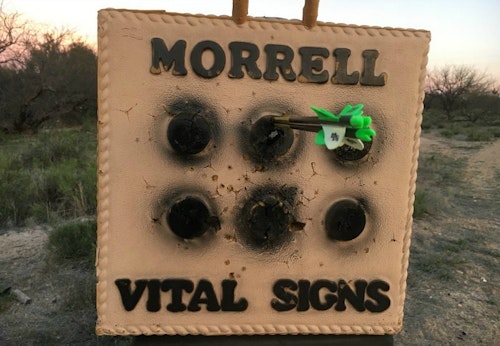I’m an old school kinda guy, one that’s slow to change to the latest and greatest hot new archery technology. I mean, why switch from what’s been treating you right? I was slow to switch from shooting fingers to a release aid, going from a long axle-to-axle bow to one that’s much shorter, try spilt limbs instead of solid. And I was very slow to hop onto the carbon-arrow train.
Part of that was because I shot some of the very first old Beman carbon shafts to come to America from France back in the 1980s. These early, micro-diameter shafts had a lot going for them. But they employed inconsistently-made outserts that could not be affixed to the shaft perfectly straight, which ruined accuracy. Also, the adhesives of the day were great when used with aluminum, but often failed to hold on carbon. And their nock system left a lot to be desired.
However, time marches on and, as it does, so does progress. Over the ensuing decades, I have watched the manufacture of carbon-hunting arrows evolve from shafts that could not compete with aluminum arrows — in terms of consistency and performance — to today’s wide selection of high-performance, consistently-straight arrows. These carbon arrows are priced right and, in my mind, meet or beat the performance of aluminum arrows under any and all conditions.
It’s not just me. Bowhunters ranging from those whose living depends on glitch-free performance to “Average Joe’s” have jumped on the carbon-arrow bandwagon in numbers so large carbon arrow sales easily eclipse aluminum and aluminum/carbon composite shafts. This stands true for both compound shooters and crossbow users.
Here are 10 reasons to shoot carbon arrows:
10) Durability
Modern carbon arrows are tougher than nails. They can take all the punishment you can give them and continue to perform as if they were brand new. This is perhaps their most impressive quality.
9) Consistent Straightness
Today’s carbon shafts from the best companies are super-straight. Virtually all top companies sell hunting arrows with a straightness of +/- .001-inch, +/- .003-inch and +/- .006-inch. Generally speaking, the straighter the arrow, the higher the price.
Bonus Tip: How straight do you need for bowhunting? “The minimum for bowhunting should be +/- .003-inch, though +/- .001-inch is much better,” said Steve Greenwood, president of Victory Archery, one of the country’s top arrow-shaft makers and a highly-accomplished bowhunter.
8) They Can’t Bend. Ever.
A carbon arrow can be flexed a lot, but it cannot be permanently bent. This is not the case with aluminum and aluminum/carbon composite arrows. “That’s why initial straightness is so important,” said Jim Velasquez, an industry veteran of more than 30 years. Velasquez currently works in a San Diego-area archery pro shop and he’s one heckuva bowhunter. “No matter how hard you pound a carbon shaft, it will remain as straight as it was when it came out of the box.”
7) Quality Components
In the “old days,” one problem with carbon arrows was the lack of quality components. This included tunable nocks and arrow-point inserts and outserts machined to space-age tolerances that could be affixed to the shaft perfectly straight, as is the case with the best aluminum arrows. The same used to be true of adhesives that worked great with aluminum, but poorly with carbon. Today, however, you can get the same component tolerances for carbon shafts as you can with aluminum arrows, as well as adhesives that are easy to use and will not come loose. Quality nocks and inserts are critical to building straight-flying arrows.

6) Quicker Recovery
Carbon shafts are stiffer than comparable aluminum arrows, meaning they recover quicker from flexing that occurs once the shaft is released. This in turn makes bow tuning simpler because a single-size carbon shaft will tune perfectly for a wider range of draw weight/arrow length combinations than aluminum arrows will.
5) Raw Arrow Speed
In many cases carbon shafts are lighter than aluminum arrows of similar spine. This, of course, means they will leave the bow faster. And faster arrows are always better than slow arrows, within reason. Modern carbon shafts also come in a wide variety of grain weight/inch, meaning you can select a shaft with the proper arrow spine for your bow/draw length. And, at the same time, get the arrow weight you want.
4) Penetration
For most bowhunting situations, both aluminum and carbon shafts penetrate plenty deeply to get the job done. However, it is a fact that the smaller-diameter, carbon shafts with their smaller fletches penetrate deeper than comparable aluminum arrows on larger animals.
3) Wind-Bucking Ability
Small-diameter, carbon shafts with three short, stiff fletches and a mechanical or low-profile replaceable-blade broadhead will definitely buck the wind better than a fatter, aluminum shaft with three, larger fletches. For those of us who hunt the West — where shots tend to be longer and the wind seems to never quit — this is a very big deal.

2) Easy To “Roll Your Own”
Early on, it was a sonofagun to build your own carbon arrows. Today, however, quality components, adhesives, and tools are readily available for the bowhunter who wants to build their own carbon arrows. That used to be true only with aluminum shafts — but not today.
1) Variety and Price
For years, the best carbon arrows cost much more than comparable aluminum shafts. And the selection of available spines and weights was not the same, either. Today it’s a snap to find the right spine and weight in grains/inch in carbon arrows from a variety of manufacturers. Also, it’s easy to find shafts in the “good, better, best” category progression that can range in cost anywhere from about $50/dozen all the way up to almost $200/dozen. The same is true for crossbow shafts. That’s very serious money, but arrow makers are finding many super-serious bowhunters who realize the arrow and broadhead are the cheapest part of the hunt. As such, they’re willing to pay for the very best.
Are Aluminum Arrows Heading Toward Extinction?
Do the above reasons mean aluminum arrows are on the way to extinction? Not at all. For example, Easton is heavily marketing their Full Metal Jacket line which features a carbon core wrapped with a 7075 aluminum alloy jacket. I’ve hunted with them a fair amount and really like them. And you can still buy aluminum shafts, which continue to account for a lot of meat in the freezer every year.
It’s just that I — and today, the majority of serious bowhunters coast to coast — have found that modern, carbon-arrow shafts offer superb performance under all conditions at a price that’s right. If you have not yet given them a try, don’t you think it is about time you did?






